Short Book Reviews
Hanna Kryszewska, Poland
Hanna Kryszewska is a teacher, teacher trainer, trainer of trainers. She is a senior lecturer at the University of Gdańsk, and EU Teacher Training College where she trains pre-service teachers. She is co-author of resource books: Learner Based Teaching, OUP, Towards Teaching, Heinemann, The Standby Book, CUP, Language Activities for Teenagers, CUP, The Company Words Keep, DELTA Publishing, and a course book series for secondary schools: ForMat, Macmillan. She is also co-author of a video based teacher training course: Observing English Lessons. Hania is a Pilgrims trainer and editor of HLT Magazine.
E-mail: hania.kryszewska@pilgrims.co.uk
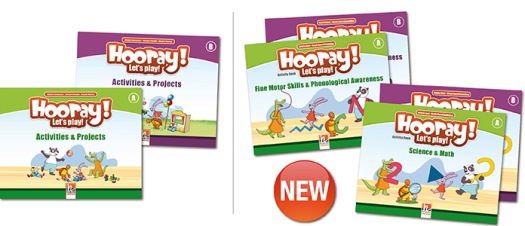
Hooray! Let’s play! Science and Maths. Activity book B. C. Aoun and N. S. Boukidjian. (2016) Helbling Languages. ISBN 978-3-99045-456-5, pp124. Hooray! Let’s play! Fine Motor Skills & Phonological Awareness. Activity book B. C. Aoun and N. S. Boukidjian. (2016) Helbling Languages. ISBN 978-3-99045-458-9, pp 74. These two activity books are aimed at supplementing the Helbling Horray! Let’s play! course. In the science section young learners explore everyday manifestations of science such as geometric figures or counting objects, or complete sequences in a logical way. The activities develop the learners’ everyday awareness of maths and science and at the same time they develop visual perception and intelligence. The exercises are beneficial to the child’s cognitive development. As for the activity book on fine motor skills and phonological awareness, in the motor skills section the learners need to colour in shapes or complete a picture. As for phonological awareness they identify words which contain a certain sound or trace a letter that represents the given sound. The fine motor skills activities are quite varied, while the phonological awareness ones seem to follow the same pattern. The workbooks are visually pleasing and in tune with the main course book.
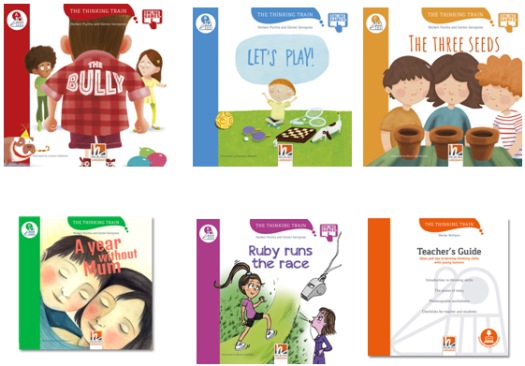
The Thinking Train. H. Puchta and G. Gerngross. (2016) Helbling Languages. The Bully. ISBN 978-3-99045-404-6, pp32, Let’s Play! ISBN 978-3-99045-405-3, pp32, The Three Seeds. ISBN 978-3-99045-406-0, pp32, A year without Mum. ISBN 978-3-99045-407-7, pp32, Ruby runs the race. ISBN 978-3-99045-408-4, pp32. Teacher’s Guide. ISBN 978-3-99045-424-4, pp16. The titles analysed in this review belong to The Thinking Train series of readers for young learners available at the five levels of the YLE Cambridge Exam; they get progressively longer and more complex grammatically and lexically. The aim of the books is to supplement the course by providing extra language practice, as well as by developing children’s thinking skills. Each book has the same structure; first pre-reading tasks which introduce or activate some of the language used in the story. Then the actual story told through text and pictures, and after reading activities which involve writing, e.g. listening or drawing, and finally a ‘make and do’ section with ideas for projects like mask making, designing a perfect room or growing a plant. As children listen or read the story they have to interact by pointing to particular pictures, miming, answering personal questions relating to the story, commenting on the story, speaking to a classmate, acting out, thinking or drawing. The stories are interesting, and beautifully illustrated. I am sure the series will be very popular with teachers and learners. Additional resources for the readers are available online. The Teacher’s Guide gives further ideas how to develop thinking skills in a young learners’ class and gives the reasons for doing so. It also explores the learners’ and the teacher’s role in teaching thinking, and the role of errors. Finally it gives a photocopiable checklist for teachers, a teacher self-appraisal check-list, and a teacher’s guide.
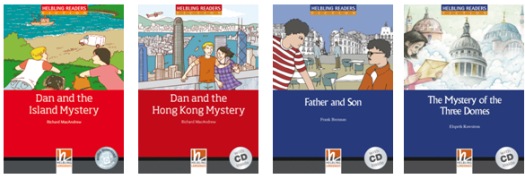
Helbling Readers Fiction. Dan and the Island Mystery. R. McAndrew. Helbling Languages (2016). ISBN-978-3-99045-257-8, pp 76. Dan and the Hong Kong Mystery. R. McAndrew. Helbling Languages (2016). ISBN-978-3-99045-396-4, pp 76. Father and Son. F. Brennan. Helbling Languages (2016). ISBN-978-3-99045-399-5, pp 64. The Mystery of Three Domes. E. Rawstron. Helbling Languages (2016). ISBN-978-3-99045-398-8, pp 84. Books in this series of graded reading materials for teenagers come at five levels, for example Dan and the Island Mystery is pitched at level 3 (A2 Waystage), and The Mystery of Three Domes at level 5 (B1 Threshold). The stories are a good read - Dan and the Island Mystery and Dan and the Hong Kong Mystery continue the adventures of Dan started in Dan and the Village Fete, while Father and Son is about relationships and helping others. Each story has a message for the readers and promotes different values. On the language level, the learners first become familiar with some lexis in the pre-reading tasks. Then as they read the story they can see the new words marked with a dot (and explained at the bottom of the page). They can also listen to the whole story and do some activities available on an accompanying audio CD. Finally there are some additional after reading activities and more activities to be found at www.helbling-ezone.com. The illustrations are pleasant to the eye, and I am sure the books will be popular among young learners as additional reading material, just like the other titles in the series.
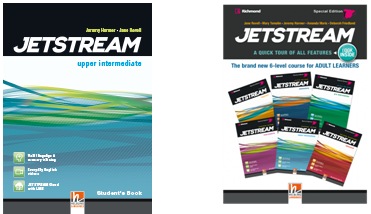
JETSTREAM. Upper Intermediate Student’s Book and Workbook. J. Harmer, J. Revell and R. Jimack Helbling Languages (2016) ISBN 978-3-85272-991-6 pp. 176+ pp 96. JETSTREAM. Advanced. M. Tomalin and D. Friedland (2016) ISBN 978-3-85272-994-7 pp. 176. This is an innovative six level course for adult learners. It aims at preparing learners to use English effectively in their professional and private lives through motivating topics which foster interest and genuine communication. Language practice, especially speaking, involves personalisation, expressing one’s own opinions and ideas. The activities are engaging, especially thanks to dialogue karaoke videos which offer an exciting way to practise real language. Also teaching speaking is strongly connected with teaching good pronunciation. The four language skills: reading, listening, speaking and writing are fully integrated around the given topic of the unit. Extra reading practice comes through lively stories at the end of the book. The authors also include culture, CLIL, critical thinking and memory activities. Vocabulary and grammar are presented and practised in meaningful contexts, with ample practice in the student’s book and workbook. There are additional fully integrated digital components with a lot of opportunities for blended learning. JETSREAM is available on www.helbling-ezone.com with a cloud version of the book and cyber homework.
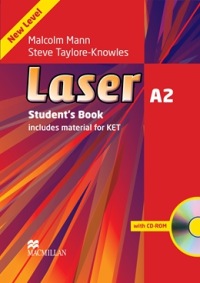
Laser: Student’s Book A 2. M. Mann and S. Taylore-Knowles. Macmillan (2012) ISBN 978-0-230-47066-8, pp 160. This book is a new addition to the well established three part general English course aimed at teenagers. This course book, just like the other books in the series, reflects the needs and interests of the learners. The book is divided into fourteen topic based units with comprehensive skills coverage, grammar and vocabulary practice. The topics are relevant to this particular age group and include cross-curricular and intercultural content, as well as tasks which require the use of English in the learners’ own environment. The course has a skills based approach, in which language functions, grammar and lexis are closely linked to the skills themselves. Production of language requires speaking and writing using motivating activities close to real life. The strong points of the course are: the Language Lab, writing planners, the Phrase Bank, the Sound Spot sections, additional materials in workbook to be used as homework and a student’s CD-ROM. The book like all the other parts in the course is pleasing to the eye with a clear layout and reasonably good photography and drawings. The book nicely completes the course.
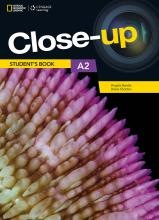
Close-Up A2. A. Bandis and D. Shotton. National Geographic Learning. CENGAGE LEARNING (2017), ISBN 978-1-4080-9684-0, pp. 181. The book is a new addition to a course designed for young adult or adult learners of English. It is an innovative course which uses spectacular National Geographic texts accompanied by fascinating texts which appeal to those who like to combine learning the language with learning about the world. The materials offer a ‘close-up’ on the surrounding world, hence the course title. The approach in the book offers a balance between language skills, grammar and vocabulary. The topics include: exploring the world, adventures, inventions, money, outer space, film and food. The earlier published coursebooks came with a theme-related National Geographic DVD with footage for each unit. This publication refers the learner to the online student zone, which includes the student’s book audio and video and workbook audio at www.eltcloseup.com The course book is pleasing to the eye, and the visual material chosen by the editor does not clash or compare unfavourably when combined with the stunning National Geographic photography. I am sure there will be many learners who will enjoy learning from the book.

Skillful ... Series. Macmillan Academic Skills: Skillful Listening & Speaking 2. D. Bohlke and R. Brinks Lockwood (this edition 2016) Macmillan. ISBN 978-0-230-49574-6, pp 110. Skillful Reading & Writing 2. L. Rogers and J. Wilkin (this edition 2016) Macmillan. ISBN 978-0-230-49573-9, pp 110. Skillful Listening & Speaking 3. M. Boyle and E. Kisslinger. (yhis edition 2016) Macmillan. ISBN 978-0-230-49576-0, pp 109. Skillful Reading & Writing 3. J. Bixby and J. Scanlon. (this edition 2016) Macmillan. ISBN 978-0-230-49575-3, pp 110. The course is aimed at students who want to prepare for the IELTS exam. Thanks to the fact that there are so many levels of the course teachers will be able to choose the right book for their students. If the need arises it is possible to use in the same class, say, a reading and writing book at level 3 and a listening and speaking book at level 2. Each unit, regardless of the level, gives a clear presentation, instant practice and skills integration. The texts and tasks are interesting, well chosen and suitable for the IELTS context. The books are ideal for short intensive exam preparation courses. Unfortunately I cannot find information stating which level corresponds to what band in the exam grading scale. Like all recently published Macmillan titles, the Skillful course has an online component.
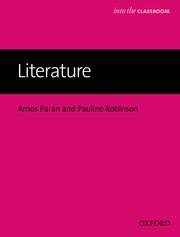
Literature. A. Paran and Pauline Robinson (2016) OUP. ISBN 978-0-19-442752-4, pp 141. This book is another title in the new OUP series: Into The Classroom, which is different from the old well established OUP series: Resource books for teachers. The books in this series are short practical guides aimed at teachers of primary and secondary school learaners. The books help the teachers to explore new teaching tools and techniques, or to become familiar with new educational policies and ways of implementing them in the classroom. The title in question focuses on how to use literature in a language class. It looks at how learning the language and learning about literature can be combined; it also gives some practical ideas of how to implement this aapproach. It advises the teachers how to choose the texts, which genres to choose, and how to use other media to teach about literature. The book is divided into 3 parts: Part 1 (establishing the groundwork) – literature and language in the EFL classroom, approaches and techniques, and what readers bring to a text, Part 2 (working with literary genres) – short stories, poetry, novels and longer works, and drama, and finally Part 3 (working with related genres) – literature and film, and literature, art and music. The activities and ideas are adaptable to different teaching contexts and classes. Using this book will help teachers to add a new dimension to their classes.
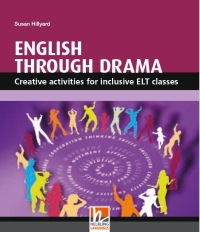
English Through Drama. Creative activities for inclusive ELT classes. S. Hillyard. Helbling Languages. (2016). ISBN 978-3-99045-409-1, pp196. This book has been published in The Resourceful Teacher Series which is written by prominent figures in English Language Teaching. It offers innovative activities which are explained step by step, and are virtually ready to be used in the class. The book in question addresses one of the areas which has been coming in and out of fashion in ELT, namely using drama in language teaching. The author’s approach goes far beyod a collection of drama ctivities which liven up language classes. The key lies in the word ‘inclusisve‘ used in the title. In the introduction the author explains how drama develops the whole learner, not just their language skills. The activities also develop social, cognitive, physical, creative and emotional skills. The book contains almost 100 activities which fall into the following categories: 1. breathing, body and mind, 2. voice and pronunciation, 3. concentration, warmers and energisers, and 4. fluency. Most of he activities are universal - suitable for all levels and age groups. The procedures are easy to follow and require hardly any preparation on the part oft he teacher. The book also contains some lesson plans and eight original mini scripts.
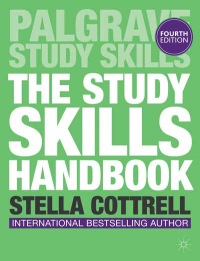
The Study Skills Handbook. Fourth edition. S. Cottrell. Palgrave Macmillan. (2013). ISBN 978-1-137-28925-4, pp426. This book has been published in the Palgrave Study Skills Series, and is a fully revised and updated edition of the original 1999 title. The book offers ideas and activities on managing onseself as a student, developing academic and people skills, and task management. The new additions, when compared to the earlier editions contains a lot of e-learning coverage, and materials including the role of success and time management. The book has been written by an expert educator who has had an impact on how generations of students have improved the ways they study ( author of Critical Thinking Skills. Developing Effective Analysis and Argument). Although the book was originally not intended for language teaching, it has a lot of implications for ELT as it touches upon the need to help students become more effective learners.
For more go to: https://he.palgrave.com/studentstudyskills/page/index/?countryChanged=true
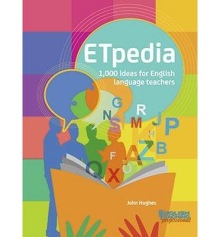
ETpedia. 1,000 ideas for English language teachers. J. Hughes (2014) Pavilion Publishing and Media. ISBN 978-0-910366-13-4, pp 272. This book is one of the first books in the new Pavilion and Media / English Teaching Professional series called ETpedia, a series of supplementary resources which contain a wealth of teaching ideas, ready activities and useful tips. The activities, tips or suggestions are grouped in 14 sections devoted to preparation and planning, classroom management, themed activities, teaching the four language skills, using ressources including those available online, using technology, and teaching grammar, vocabulary and pronunciation.The last two sections look at slightly different areas. The first one deals with teaching in various age groups, at different levels, in different contexts such as state or private, teaching monolingual or mixed ability classes and many other; the second looks at further development the teachers themselves might choose such as training courses or various career paths. Finally, in the appendix, you will find photocopiable material for some of the activities. Overall the resource offers a wealth of materials and food for thought for less and more experienced teachers. It is also a useful resource for trainers delivering pre-service and in-service teacher training courses.
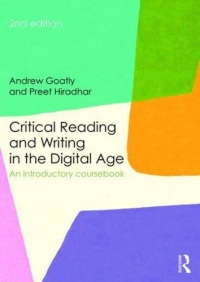
Critical Reading and Writing in the Digital Age. An introductory coursebook. 2nd edition A. Goatly and P. Hiradhar. (2016). Routledge ISBN 978-0-415-84262-4, pp 334. The book is an excellent introduction to developing critical reading skills, especially for those who have to read texts for study purposes. Also it helps to reflect on vital issues of our times and observe how language shapes the society we live in. The introduction outlines how the book can be used for self study and in class, and advice on how to use the web resources that accompany the book. The main body of the book falls into three parts: Part A is devoted to critical reading of a text, Part B to reading deep into a text, and Part C to authority and power behind discourse. The book is interactive and involves active participation in text analysis. The texts include different genres such as fiction, poetry or advertisement. The students/ users of the book analyse texts not only as a reader, but also reflect on the choices the author of the text makes when structuring a text, how he or she represents the world and positions the reader. This is book is a real eye opener and offers a new approach to reading classes. It is an excellent book for learners of English at high levels.

Please check the Creative Methodology for the Classroom course at Pilgrims website.
Please check the Methodology & Language for Kindergarten Teachers course at Pilgrims website.
Please check the Methodology and Language for Primary Teachers course at Pilgrims website.
Please check the Methodology and Language for Secondary Teachers course at Pilgrims website.
Please check the Teaching Advanced Students course at Pilgrims website.
Please check the English Language Improvement for Teachers course at Pilgrims website.
Please check the English Language Improvement for Adults course at Pilgrims website.
Please check the Teaching Advanced Students course at Pilgrims website.
Please check the Practical Uses of Technology in the Classroom course at Pilgrims website.
Please check the How to be a Teacher Trainer course at Pilgrims website.


|